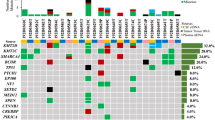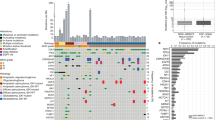Abstract
Brainstem gliomas are molecularly heterogeneous diseases, many of which are difficult to safely surgically resect and have limited treatment options due to their eloquent location. These constraints pose challenges to biopsy, which limits the use of routine molecular profiling and identification of personalized therapies. Here, we explored the potential of sequencing of circulating tumor DNA (ctDNA) isolated from the cerebrospinal fluid (CSF) of brainstem glioma patients as a less invasive approach for tumor molecular profiling. CSF was obtained from patients either intraoperatively (91.2%, 52/57), from ventricular-peritoneal shunt (3.5%, 2/57), or by lumbar puncture (5.3%, 3/57), all prior to surgical manipulation of the tumor. Deep sequencing of glioma-associated genes was performed on CSF-derived ctDNA and, where available, matched blood and tumor DNA from 57 patients, including nine medullary and 23 diffuse intrinsic pontine gliomas (DIPG). At least one tumor-specific mutation was detected in over 82.5% of CSF ctDNA samples (47/57). In cases with primary tumors harboring at least one mutation, alterations were identified in the CSF ctDNA of 97.3% of cases (36/37). In over 83% (31/37) of cases, all primary tumor alterations were detected in the CSF, and in 91.9% (34/37) of cases, at least half of the alterations were identified. Among ten patients found to have primary tumors negative for mutations, 30% (3/10) had detectable somatic alterations in the CSF. Finally, mutation detection using plasma ctDNA was less sensitive than sequencing the CSF ctDNA (38% vs. 100%, respectively). Our study indicates that deep sequencing of CSF ctDNA is a reliable technique for detecting tumor-specific alterations in brainstem tumors. This approach may offer an alternative approach to stereotactic biopsy for molecular profiling of brainstem tumors.




Similar content being viewed by others
References
Bettegowda C, Sausen M, Leary RJ, Kinde I, Wang Y, Agrawal N et al (2014) Detection of circulating tumor DNA in early- and late-stage human malignancies. Sci Transl Med 6:224. https://doi.org/10.1126/scitranslmed.3007094
Buczkowicz P, Hoeman C, Rakopoulos P, Pajovic S, Letourneau L, Dzamba M et al (2014) Genomic analysis of diffuse intrinsic pontine gliomas identifies three molecular subgroups and recurrent activating ACVR1 mutations. Nat Genet 46:451–456. https://doi.org/10.1038/ng.2936
Bugiani M, Veldhuijzen van Zanten SEM, Caretti V, Schellen P, Aronica E, Noske DP et al (2017) Deceptive morphologic and epigenetic heterogeneity in diffuse intrinsic pontine glioma. Oncotarget 8:60447–60452. https://doi.org/10.18632/oncotarget.19726
Castel D, Philippe C, Calmon R, Le Dret L, Truffaux N, Boddaert N et al (2015) Histone H3F3A and HIST1H3B K27M mutations define two subgroups of diffuse intrinsic pontine gliomas with different prognosis and phenotypes. Acta Neuropathol 130:815–827
Cracolici V, Mujacic I, Kadri S, Alikhan M, Niu N, Segal JP et al (2018) Synchronous and metastatic papillary and follicular thyroid carcinomas with unique molecular signatures. Endocr Pathol 29:9–14. https://doi.org/10.1007/s12022-017-9491-6
De Mattos-Arruda L, Mayor R, Ng CK, Weigelt B, Martinez-Ricarte F, Torrejon D et al (2015) Cerebrospinal fluid-derived circulating tumour DNA better represents the genomic alterations of brain tumours than plasma. Nat Commun 6:8839. https://doi.org/10.1038/ncomms9839
Diaz LA Jr, Bardelli A (2014) Liquid biopsies: genotyping circulating tumor DNA. J Clin Oncol 32:579–586. https://doi.org/10.1200/JCO.2012.45.2011
Fedorov A, Beichel R, Kalpathy-Cramer J, Finet J, Fillion-Robin JC, Pujol S et al (2012) 3D Slicer as an image computing platform for the quantitative imaging network. Magn Reson Imaging 30:1323–1341. https://doi.org/10.1016/j.mri.2012.05.001
Fisher BJ, Hu C, Macdonald DR, Lesser GJ, Coons SW, Brachman DG et al (2015) Phase 2 study of temozolomide-based chemoradiation therapy for high-risk low-grade gliomas: preliminary results of Radiation Therapy Oncology Group 0424. Int J Radiat Oncol Biol Phys 91:497–504. https://doi.org/10.1016/j.ijrobp.2014.11.012
Fontebasso AM, Papillon-Cavanagh S, Schwartzentruber J, Nikbakht H, Gerges N, Fiset PO et al (2014) Recurrent somatic mutations in ACVR1 in pediatric midline high-grade astrocytoma. Nat Genet 46:462–466. https://doi.org/10.1038/ng.2950
Frazier JL, Lee J, Thomale UW, Noggle JC, Cohen KJ, Jallo GI (2009) Treatment of diffuse intrinsic brainstem gliomas: failed approaches and future strategies: a review. J Neurosurg Pediatr 3:259–269. https://doi.org/10.3171/2008.11.peds08281
Gerasimidis K, Bertz M, Quince C, Brunner K, Bruce A, Combet E et al (2016) The effect of DNA extraction methodology on gut microbiota research applications. BMC Res Notes 9:365. https://doi.org/10.1186/s13104-016-2171-7
Hargrove D, Bartels U, Bouffet E (2006) Diffuse brainstem glioma in children: critical review of clinical trials. Lancet Oncol 7:241–248. https://doi.org/10.1016/s1470-2045(06)70615-5
Hoffman LM, DeWire M, Ryall S, Buczkowicz P, Leach J, Miles L et al (2016) Spatial genomic heterogeneity in diffuse intrinsic pontine and midline high-grade glioma: implications for diagnostic biopsy and targeted therapeutics. Acta Neuropathol Commun 4:1. https://doi.org/10.1186/s40478-015-0269-0
Huang TY, Piunti A, Lulla RR, Qi J, Horbinski CM, Tomita T et al (2017) Detection of histone H3 mutations in cerebrospinal fluid-derived tumor DNA from children with diffuse midline glioma. Acta Neuropathol Commun 5:28. https://doi.org/10.1186/s40478-017-0436-6
Jansen MH, van Zanten SEV, Aliaga ES, Heymans MW, Warmuth-Metz M, Hargrave D et al (2015) Survival prediction model of children with diffuse intrinsic pontine glioma based on clinical and radiological criteria. Neuro Oncol 17:160–166
Jiang T, Li X, Wang J, Su C, Han W, Zhao C et al (2017) Mutational landscape of cfDNA identifies distinct molecular features associated with therapeutic response to first-line platinum-based doublet chemotherapy in patients with advanced NSCLC. Theranostics 7:4753–4762. https://doi.org/10.7150/thno.21687
Johung TB, Monje M (2017) Diffuse intrinsic pontine glioma: new pathophysiological insights and emerging therapeutic targets. Curr Neuropharmacol 15:88–97
Kadri S, Long BC, Mujacic I, Zhen CJ, Wurst MN, Sharma S et al (2017) Clinical validation of a next-generation sequencing genomic oncology panel via cross-platform benchmarking against established amplicon sequencing assays. J Mol Diagn 19:43–56. https://doi.org/10.1016/j.jmoldx.2016.07.012
Kieran MW, Goumnerova LC, Prados M, Gupta N (2016) Biopsy for diffuse intrinsic pontine glioma: a reappraisal. J Neurosurg Pediatr 18:390–391. https://doi.org/10.3171/2015.6.PEDS15374
Klimo P, Panandiker ASP, Thompson CJ, Boop FA, Qaddoumi I, Gajjar A et al (2013) Management and outcome of focal low-grade brainstem tumors in pediatric patients: the St. Jude experience. J Neurosurg Pediatr 11:274–281. https://doi.org/10.3171/2012.11.peds12317
Long W, Yi Y, Chen S, Cao Q, Zhao W, Liu Q (2017) Potential new therapies for pediatric diffuse intrinsic pontine glioma. Front Pharmacol 8:495. https://doi.org/10.3389/fphar.2017.00495
Mackay A, Burford A, Carvalho D, Izquierdo E, Fazal-Salom J, Taylor KR et al (2017) Integrated molecular meta-analysis of 1,000 pediatric high-grade and diffuse intrinsic pontine glioma. Cancer Cell 32(520–537):e525. https://doi.org/10.1016/j.ccell.2017.08.017
Mandell LR, Kadota R, Freeman C, Douglass EC, Fontanesi J, Cohen ME et al (1999) There is no role for hyperfractionated radiotherapy in the management of children with newly diagnosed diffuse intrinsic brainstem tumors: results of a Pediatric Oncology Group phase III trial comparing conventional vs. hyperfractionated radiotherapy. Int J Radiat Oncol Biol Phys 43:959–964
Martinez-Ricarte F, Mayor R, Martinez-Saez E, Rubio-Perez C, Pineda E, Cordero E et al (2018) Molecular diagnosis of diffuse gliomas through sequencing of cell-free circulating tumour DNA from cerebrospinal fluid. Clin Cancer Res. https://doi.org/10.1158/1078-0432.ccr-17-3800
Nikbakht H, Panditharatna E, Mikael LG, Li R, Gayden T, Osmond M et al (2016) Spatial and temporal homogeneity of driver mutations in diffuse intrinsic pontine glioma. Nat Commun 7:11185. https://doi.org/10.1038/ncomms11185
Olar A, Wani KM, Alfaro-Munoz KD, Heathcock LE, van Thuijl HF, Gilbert MR et al (2015) IDH mutation status and role of WHO grade and mitotic index in overall survival in grade II-III diffuse gliomas. Acta Neuropathol 129:585–596. https://doi.org/10.1007/s00401-015-1398-z
Pan CC, Chen X, Xu C, Wu WH, Zhang P, Wang Y et al (2016) Brainstem gangliogliomas: prognostic factors, surgical indications and functional outcomes. J Neurooncol 128:445–453. https://doi.org/10.1007/s11060-016-2131-z
Pentsova EI, Shah RH, Tang J, Boire A, You D, Briggs S et al (2016) Evaluating cancer of the central nervous system through next-generation sequencing of cerebrospinal fluid. J Clin Oncol 34:2404–2415. https://doi.org/10.1200/JCO.2016.66.6487
Puget S, Beccaria K, Blauwblomme T, Roujeau T, James S, Grill J et al (2015) Biopsy in a series of 130 pediatric diffuse intrinsic pontine gliomas. Childs Nerv Syst 31:1773–1780. https://doi.org/10.1007/s00381-015-2832-1
Puget S, Philippe C, Bax DA, Job B, Varlet P, Junier MP et al (2012) Mesenchymal transition and PDGFRA amplification/mutation are key distinct oncogenic events in pediatric diffuse intrinsic pontine gliomas. PLoS One 7:e30313. https://doi.org/10.1371/journal.pone.0030313
Roujeau T, Di Rocco F, Dufour C, Bourdeaut F, Puget S, Sainte Rose C et al (2011) Shall we treat hydrocephalus associated to brain stem glioma in children? Childs Nerv Syst 27:1735–1739. https://doi.org/10.1007/s00381-011-1538-2
Saratsis AM, Kambhampati M, Snyder K, Yadavilli S, Devaney JM, Harmon B et al (2014) Comparative multidimensional molecular analyses of pediatric diffuse intrinsic pontine glioma reveals distinct molecular subtypes. Acta Neuropathol 127:881–895. https://doi.org/10.1007/s00401-013-1218-2
Taylor KR, Mackay A, Truffaux N, Butterfield Y, Morozova O, Philippe C et al (2014) Recurrent activating ACVR1 mutations in diffuse intrinsic pontine glioma. Nat Genet 46:457–461. https://doi.org/10.1038/ng.2925
Vanan MI, Eisenstat DD (2015) DIPG in children—what can we learn from the past? Front Oncol 5:237. https://doi.org/10.3389/fonc.2015.00237
Veldhuijzen van Zanten SEM, Lane A, Heymans MW, Baugh J, Chaney B, Hoffman LM et al (2017) External validation of the diffuse intrinsic pontine glioma survival prediction model: a collaborative report from the International DIPG Registry and the SIOPE DIPG Registry. J Neurooncol. https://doi.org/10.1007/s11060-017-2514-9
Wang Y, Springer S, Zhang M, McMahon KW, Kinde I, Dobbyn L et al (2015) Detection of tumor-derived DNA in cerebrospinal fluid of patients with primary tumors of the brain and spinal cord. Proc Natl Acad Sci USA 112:9704–9709. https://doi.org/10.1073/pnas.1511694112
Wu G, Broniscer A, McEachron TA, Lu C, Paugh BS, Becksfort J et al (2012) Somatic histone H3 alterations in pediatric diffuse intrinsic pontine gliomas and non-brainstem glioblastomas. Nat Genet 44:251–253. https://doi.org/10.1038/ng.1102
Wu G, Diaz AK, Paugh BS, Rankin SL, Ju B, Li Y et al (2014) The genomic landscape of diffuse intrinsic pontine glioma and pediatric non-brainstem high-grade glioma. Nat Genet 46:444–450. https://doi.org/10.1038/ng.2938
Zhang L, Chen LH, Wan H, Yang R, Wang Z, Feng J et al (2014) Exome sequencing identifies somatic gain-of-function PPM1D mutations in brainstem gliomas. Nat Genet 46:726–730. https://doi.org/10.1038/ng.2995
Acknowledgements
Funding
Financial support was provided by the National Key Technology Research and Development Program of the Ministry of Science and Technology of China (Grant nos. 2014BAI04B01 and 2015BAI12B04), Beijing Municipal Administration of Hospitals Clinical Medicine Development of Special Funding Support (Grant no. ZYLX201608), and Grant for CP from Beijing Municipal Bureau of Human Resources and Social Security (Grant no. 2017-ZZ-117).
Author information
Authors and Affiliations
Contributions
LZ, HY, and BHD designed the study. CP, XC, YW, XX, YG, PZ, WW, and YW collected the samples, CP, and LJ performed the experiments and collected the data. CP, LJ, YJ, and LZ analyzed the results. CP, LJ, BHD, HY, and LZ wrote the manuscript. CX, YS, ZW, JZ, and YJ, gave conceptual advice.
Corresponding authors
Ethics declarations
Conflict of interest
HY is a founder of Genetron Health and receives royalties from Personal Genome Diagnostics (PGDX) and Agios. YJ is a co-founder of and Scientific Advisor for Genetron Health. BHD serves as a scientific consultant for Genetron Health.
Electronic supplementary material
Below is the link to the electronic supplementary material.
401_2018_1936_MOESM7_ESM.tif
Supplementary material 7 Detection of brain tumor-associated alterations in tumor tissue DNA and CSF-derived ctDNA. Comparing the portions of patients with detectable somatic alterations in 47 patients with available matched CSF ctDNA and tumor tissue DNA reveals that the CSF shows similar patterns to tumor DNA across different a tumor types, b tumor locations and c tumor volumes. (TIFF 20275 kb)
Rights and permissions
About this article
Cite this article
Pan, C., Diplas, B.H., Chen, X. et al. Molecular profiling of tumors of the brainstem by sequencing of CSF-derived circulating tumor DNA. Acta Neuropathol 137, 297–306 (2019). https://doi.org/10.1007/s00401-018-1936-6
Received:
Revised:
Accepted:
Published:
Issue Date:
DOI: https://doi.org/10.1007/s00401-018-1936-6




